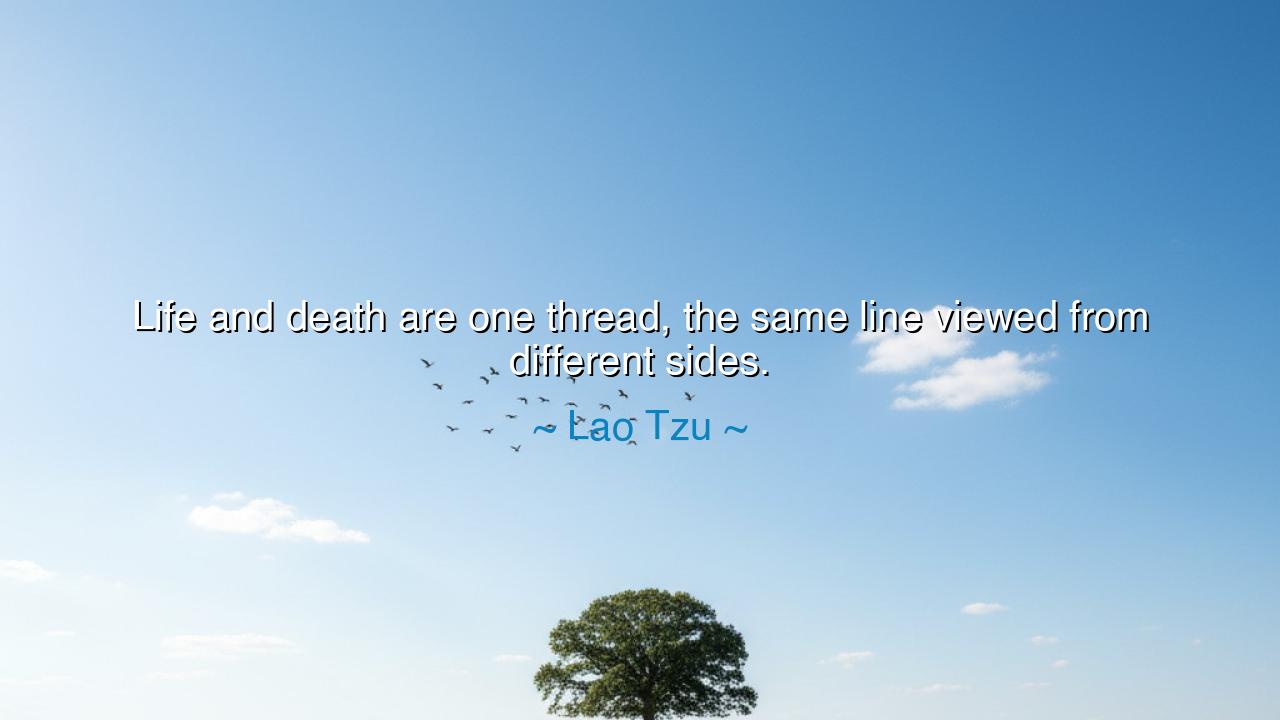
Life and death are one thread, the same line viewed from






“Life and death are one thread, the same line viewed from different sides.” — so spoke Lao Tzu, the sage of ancient China, whose words still echo through the corridors of time like the whisper of wind through bamboo. In this single sentence, he unveils a truth so profound that it transcends philosophy and becomes revelation: that life and death are not opposites, but companions; not enemies, but reflections of the same eternal flow. They are not two paths diverging, but one thread, woven by the unseen hand of the Tao — the Way that sustains all things.
The origin of this wisdom comes from the Tao Te Ching, the sacred text attributed to Lao Tzu, written over two millennia ago. Living in an age of conflict and ambition, Lao Tzu sought harmony not through conquest or striving, but through understanding the natural rhythm of existence. To him, the Tao — the cosmic Way — was the pulse of the universe, in which all opposites are reconciled: light and shadow, joy and sorrow, life and death. He saw that these dualities do not battle one another; rather, they give meaning to one another, as night reveals the stars and silence gives shape to sound. Death, he teaches, is not the end of life but the completion of its circle — the return to the source from which all things flow.
To grasp this truth is to stand in awe of the seamlessness of creation. The child emerges from the womb into the world, as surely as the spirit departs from the body into another mystery. Both are crossings, both are transformations. Lao Tzu reminds us that what we call death is not the extinguishing of being, but the turning of the thread, the continuation of the pattern from another side. The river that disappears beneath the earth is not gone — it flows unseen until it rises again in another place, renewed and free. So it is with us, who are woven into the endless fabric of the Tao.
Consider, for example, the story of the cherry blossom in Japan — a flower that blooms for only a brief moment each spring. Its beauty is radiant but fleeting, and when the wind carries its petals away, the people do not mourn; they celebrate. For they know that the blossom’s fall is not death, but fulfillment — its delicate descent completes the purpose of its existence. In its fading lies its perfection. So, too, Lao Tzu teaches, must we learn to see the falling of life’s blossoms — the moments of loss, the end of seasons, the passing of souls — not as destruction, but as the natural turning of the thread.
This wisdom, though ancient, offers healing for the hearts of today. We, the children of modern times, have learned to fear death as a thief and to cling to life as though it were a possession. Yet Lao Tzu would tell us that to grasp life too tightly is to lose its essence, just as one cannot capture the wind by closing one’s hand around it. To live well is to flow with the Tao — to accept change, to yield when it is time, to trust that what seems to end is only shifting form. When we cease to resist the turning of the thread, we find peace not only in living, but also in letting go.
It was said of the Buddha, too, that when his disciples wept at his passing, he asked them, “Why do you grieve? All compounded things must dissolve. This is the way of the world.” His body was gone, but his teaching — his essence — continued, like the fragrance of a flower long after the bloom has fallen. Thus, both Lao Tzu and the Buddha understood the same eternal rhythm: that life and death are bound together in a dance that never ends. To lament one is to misunderstand the other.
Therefore, my listener, take this teaching to heart: do not fear death, for it is not the end, but the turning of the line. Do not cling too tightly to life, for in doing so, you lose its grace. Instead, live each moment as part of the eternal thread — be present in the weaving. When joy comes, embrace it; when sorrow visits, honor it; when the time of departure arrives, meet it with calm, as the wave returns to the ocean. In this acceptance lies true freedom, the peace of one who walks in harmony with the Way.
For Lao Tzu’s wisdom is not a call to detachment, but to understanding — to see all things as parts of one whole. Life and death are not two stories, but two verses of the same song. Learn to listen for the music beneath them, and you will discover that there has never been an end — only a continuation, a transformation, a returning home. Thus the wise live without fear, die without regret, and dwell forever in the flow of the eternal Tao.






AAdministratorAdministrator
Welcome, honored guests. Please leave a comment, we will respond soon